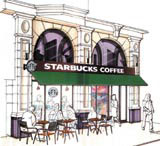So full of beans
Mike Exon finds out what is brewing in the London camp of international coffee chain Starbucks with its head of store development in the UK, Jason Pior

Jason Pior’s CV
1966 Born in the Midlands
1995 Joined quantity surveyor Walker Cotter
1998 Brand development manager at Bass Leisure Retail
2001 Head of store development at Starbucks
As you walk into Starbucks’ London offices in leafy Parsons Green, it’s easy to forget the vastness of its coffee empire. Set in a modest back street mews, there isn’t so much as a whiff of world domination about the place, though the ‘help yourself’ coffee in reception nips at the nostrils in a different way. The only faint reminder of Starbucks’ ‘big bad brand’ media image is the fair-trade poster on the wall insisting it pays a premium for beans to support its coffee growers, as if to silence its critics.
It’s appropriate that the offices are understated. Interpreting Starbucks for the British is exactly what this operation is all about and a corporate cathedral would smack of vulgarity. As head of store development for Starbucks, Jason Pior spends a lot of his time ensuring this big American brand works for the British customer. And that can sometimes mean taking the brashness out.
‘I am responsible for the design and construction of all our new stores, plus the renovation work of our existing stores,’ says Pior. He heads up a team of eight who are ‘essentially project managers’, including design manager Sarah Malcolm. Together they work with Starbucks’ global design team in Seattle to co-ordinate the UK roll-out of the brand footprint at retail. You could say it’s a classic case of think global, act local.
In his younger years, Pior decided against training as an accountant and after a stint with his father’s shopfitting business found solace in the ways of quantity surveying. He joined a practice near home and soon found himself in a management position, where he controlled a lot of key accounts with blue chip leisure clients like Beefeater Restaurants.
‘I gained a lot of experience in what I call the fashion market; a lot of pubs and restaurants are about what the fashion of today is and are constantly re-inventing themselves all the time,’ he explains.
This set him up for a position as brand development manager at Bass Leisure Retail (now Six Continents),where he was given a much wider role.
‘At Bass Leisure Retail I managed the design consultants and oversaw the roll-outs of Edward’s bars and Ember Inns, which is a contemporary community pub that are still rolling out today.’
Pior’s work with Ember Inns, which was about re-inventing the pub as a comfortable getaway with good food, cosy fireplaces and homely interiors, caught the attention of Starbucks, whose own philosophy was not dissimilar. At this time in 2001, the coffee chain had already acquired the Seattle Coffee Company to get a late foothold in the UK market and was embarking on a national coverage plan. It had about 135 outlets, says Pior. Two years on it has 350.
‘I joined in January 2001, with a remit to drive through the aggressive expansion programme and to translate the Starbucks offer into the UK,’ he says. ‘Starbucks talks a lot about “wanting to be the third place”. The first is your home, the second is your place of work and Starbucks wants to be that place you go to if, say, you are leaving work and you don’t want to go straight home. One of the challenges is how does a coffee shop reach that status, because for the British that place has always been the pub.’
But Pior’s time at Bass had already shown him how the days of ‘pub as hub’ were on the wane. Pubs were not much good for children, nor were they popular with individual women. The coffee shop, with its clean interiors, high dwell times, newspapers, cheery baristas and comfy chairs, was a perfect riposte to the smoky, beery, old man’s pub.
‘In terms of design, Starbucks has four types of store, each with its own colour palette, texture and feel. We are sometimes criticised for having too many stores in close proximity, but one of the things we try to do is create different environments for neighbouring stores,’ Pior continues. Each format is rolled out using a fairly consistent toolbox approach, with specific creative input borrowed from the Seattle team, which has overall ‘brand ownership’.
Starbucks’ involvement with consultancies is largely at the marketing communications level, though Pior and Malcolm do work with retail design groups and architects when the brief calls for it. Recently, the team has done store profiling and store template work with Middlesex group RPA Architectural Consultants.
‘I’m sure we’d drive some people mad the way we work,’ he laughs, ‘The thing is, there is no one formula for what we do, there is no one way of doing things, it’s all about evolution.’
Aside from the main rollout programme, which has seen Pior and his team open 40 stores in the past six months (largely acquisitions like the 12 Coffee Republic stores it just picked up), there have been plenty of new initiatives out of the UK. Starbucks’ partnership with the American bookshop chain Borders is surprisingly a UK-only venture for instance. And Pior has also just presented to his US colleagues on the potential for adapting the Starbucks kiosks his team came up with for Britain’s train stations.
The opportunity for Starbucks to push further into Britain’s existing third spaces such as bookshops, cinemas and shopping centres looks substantial. It has just opened an experimental store inside a retail park in Hull, for instance, that Pior describes as a futuristic, pod-like place with a climbing wall, of all things.
It seems even climbers like to wake up and smell the coffee.
-
Post a comment




